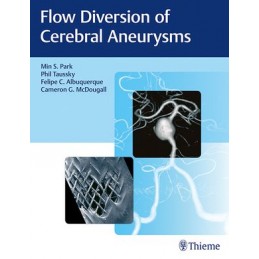- Reduced price

Order to parcel locker

easy pay


 Delivery policy
Delivery policy
Choose Paczkomat Inpost, Orlen Paczka, DHL, DPD or Poczta Polska. Click for more details
 Security policy
Security policy
Pay with a quick bank transfer, payment card or cash on delivery. Click for more details
 Return policy
Return policy
If you are a consumer, you can return the goods within 14 days. Click for more details
Seminal resource on state-of-the-art flow diversion techniques from leading neurointerventional experts
From detachable balloons and GDC coils to the recent advent of flow diversion, practitioners of endovascular neurosurgery have been fortunate to work in an era of rapid and exciting advances. The first commercially available flow diverter in the U.S. was approved specifically for a small subset of cerebral aneurysms. Recent experience has demonstrated its utility in treating challenging or otherwise untreatable aneurysms, safely and efficaciously. The design of these devices requires learning radically different methods than those used in the deployment of other, non-braided stents.
Flow Diversion of Cerebral Aneurysms by Min Park, Philipp Taussky, Felipe Albuquerque, and Cameron McDougall provides step-by-step guidance on utilization of flow diversion technology in clinical practice. Reflecting the combined experience and knowledge of pioneers in neurointerventional surgery, this comprehensive book fills a gap in available resources. Twenty-one chapters cover fundamentals to advanced concepts - historical perspective to future developments.
Key Features
The ultimate goal of incorporating cutting-edge flow diversion techniques into the aneurysm treatment paradigm is improved efficacy and patient outcome. The knowledge gleaned from this outstanding resource will help residents and fellows learn to deploy flow diverters for the first time and enable seasoned clinicians to expand their neurointerventional radiology skills.
Data sheet
1. The Beginnings of Flow Diversion: A Historical Review
2. Theoretical Basis of Flow Diversion
3. Review of Current Literature and Occlusion Results
4. Coil Embolization versus Flow Diversion
5. On-Label Use (Illustrative Cases)
6. Off-Label Use
7. Flow Diversion in Ruptured Aneurysms
8. Pharmacology for Flow Diversion
9. Overview of Current Flow-Diverting Devices
10. Techniques and Nuances of Pipeline Deployment
11. Technique and Nuances of Silk Deployment (Balt Extrusion)
12. Technique and Nuances of Surpass Streamline Flow Diverter
13. Technique and Nuances of Deployment of the Flow Re-Direction Endoluminal Device
14. Adjuvant Techniques to Improve Flow Diversion
15. Flow Diverters for Brain Aneurysm Treatment: Intraprocedural Complications and Management
16. Postprocedural Complications
17. Flow Diversion Grading Scales
18. Radiographic Imaging after Flow Diversion
19. Management of Aneurysm Residuals Following Treatment with Flow Diverters
20. Hemodynamic Modifications of Flow-Diverting Stents
21. Future Developments and Research
